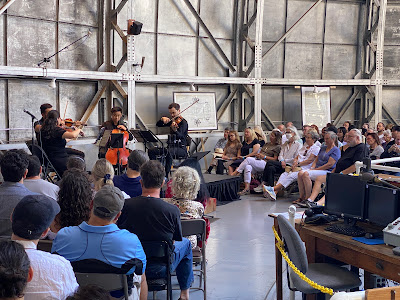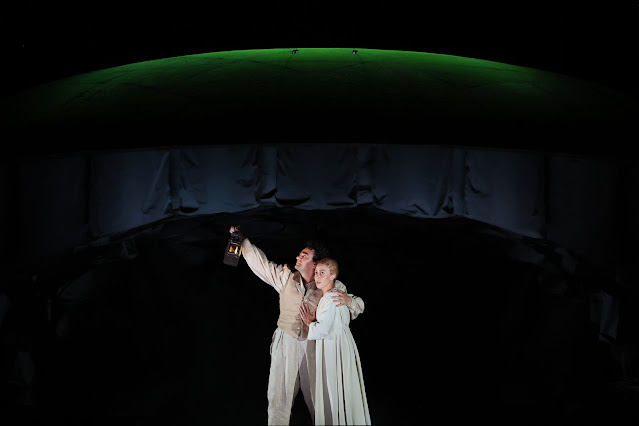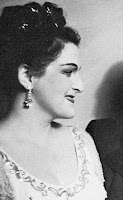REVIEW
Zelter String Quartet play Mason, Puccini, and Mendelssohn, Mount Wilson Observatory
JOHN STODDER
“Why are we so lucky?” I asked Nicolette, my wife and date for the August 13 performance of the Zelter String Quartet at Mount Wilson Observatory. It was a beautiful midsummer Sunday, with sparkling clear air once we rose out of the hazy LA basin. The switchbacking path of the Angeles Crest Highway displayed the San Gabriel Mountains at the ideal time of day as we headed up the mountain for the 3 p.m. concert. Then, boom, 30 seconds after we parked and locked our car, the Mount Wilson shuttle arrived with two seats unoccupied. That was when I asked my rhetorical question, as we rode the final stretch to the 100-inch Hooker telescope and the dome where the concert would be played.
 |
| Cécilia Tsan. |
The concert stage utilizes half of a donut-shaped balcony surrounding the great telescope that discovered the larger universe, no less. This steel floor once supported the hurried footsteps of the world’s most accomplished astronomers, mechanical engineers and telescope "fix-its." To make it into a performance space, risers are placed in an open location on one side of the telescope, abutting the dome’s interior wall. That’s for the performers. Wings of folding chairs extend to each side, perhaps 15 rows, 10 seats wide, in both directions, so it has something of a theater-in-the-round feeling.
The sightlines are good, but because there’s no elevation for the audience, seats near the front are preferred. From an audibility standpoint, there isn’t a bad seat. The acoustics are surprisingly pure considering music was the farthest thing from what it was built for. There’s a bit more reverb than is fashionable now in concert halls, but to my ears, the echo is minimal, natural, and pleasing.
 |
| Mount Wilson Institute Trustee Dan Kohne introduces the concert—and its unique venue. |
Besides the opportunity to return to Mount Wilson, this concert was circled on our calendar because the Zelter String Quartet are exceptional. This would be my second time hearing them. I had no doubt they would command the Mount Wilson space, and indeed they did.
The point of a string quartet is to present a kind of real-time musical conversation among four strong voices given equal access to the ears of the audience. Joseph Haydn, the father of the string quartet, strove to embody democracy in this form, and composers since then have written quartets according to that principle. But what are the four equal voices meant to model? An idealized debate in which each unique voice is heard? Or are we meant to hear a single voice, expressed in multiple dimensions?
To be sure, every quartet and every composer of quartets exploits both capabilities. Still, Zelter’s members struck me as unusually well-connected musically. They strive, and succeed, in creating one voice: rich, soulful and alive. They accomplish this magic via a mindfulness that is palpable. You can see it in these musicians' eyes and body language, in addition to hearing it in their blend: they listen intently to each other, and use what they hear to make constant subtle adjustments so that the collective voice is as beautifully balanced as possible. From brief, post-concert conversations with Zelter members, I confirmed the ensemble’s intramural responsiveness is something they work on and are proud of. As if to underscore that egalitarian vibe, there is no “first violinist” in Zelter. Kyle Gilner and Gallia Kastner changed seats between the second and third piece.
All of this goodness came together to give the audience an unforgettable concert, with performances of music by LA native Todd Mason (producer of the Mason House concerts in West Los Angeles), the late 19th century Italian opera maestro Giacomo Puccini, and an Early Romantic masterpiece from an 18-year-old Felix Mendelssohn. It was a serious program that launched journeys into space-time, into depths of mourning, and finally into an explosion of youthful passions guided by genius.
 |
| Todd Mason. |
At first, the abstract, atonal effects seemed out of character for Mason, who can be counted on to bend and stretch tonality, but seldom break it. As it unfolded, his plan became clearer as the music cycled through moments of chaos followed by a fragile sense of order before breaking apart again—a metaphor not just for science but all creativity, with an underlying, poignant question: “Is order just an illusion?” Mason set up interesting contrasts between the two violin parts, with Gilner handling a series of virtuosic, almost frenzied statements, only to be answered sorrowfully and emotively by Kastner. The array of string sounds and varying dynamics Mason asked Zelter to perform also served as a kind of acoustical test for Mount Wilson, which the building passed without difficulty.
Puccini’s Crisantemi (1890) was next. Do opera fans know what beautiful chamber music their icon wrote? You can find what little there is on streaming services, and it’s worth the hunt. This piece, whose title translates to "Chrysanthemums," was said to be composed in one night, and captured the composer’s grief over the death of his friend, the Duke of Aosta, who ruled for three years as King Amadeo I of Spain and was part of the Italian royal dynasty known as the House of Savoy. It’s unclear why Puccini loved the Duke so much. A quick review of his bio suggests he was not especially worthy of the depths of emotion evoked in this brief composition. But love is love, right? Plus the Duke was very wealthy.
 |
| Giacomo Puccini, c.1890. |
Neither the Puccini nor Mason pieces conformed with the usual expectations for a string quartet concert. Hearing them back to back at the beginning of the concert had the effect of expanding our awareness of what the quartet form could be, which proved to be the perfect set-up for Zelter’s performance of Mendelssohn’s String Quartet No. 2 in A minor (1827). It’s an extraordinary composition, and not just because he was only 18 when he wrote it. While it largely adheres to the classical string quartet structure, by the time the Zelter Quartet got to it, we in the audience were ready to hear it without too much regard for stereotypes.
When you’re young, certain years take on added drama because of a confluence of new experiences that can both inspire and overwhelm the developing mind. For the young Felix Mendelssohn, 1827 apparently was such a year, when two events affected him deeply. First, he fell in love with someone whose name is lost to history, but who inspired him to write a song entitled Frage, with a lyric that began:
“Is it true that you always wait for me there in the leafy path by the grape arbor and ask the moonlight and the little stars about me?"
 |
| "Beethoven nears the end." |
 |
| Felix Mendelssohn. |
Each of the quartet members were given moments to display their individual tone, but what excited me most is what they created together, in twos, threes and fours; in rounds and ensembles and passages charged with dance rhythms; and in solemn moments of regret and loss. They gave us an emotion-filled concert, a deeply satisfying artistic journey that was enhanced by the Mount Wilson dome, and transcended it.
In his opening speech, Mount Wilson Trustee Dan Kohne hoped to encourage the audience to be judicious with their camera-phones. It was tempting to try to capture the experience, the unusual visuals accompanied by beautiful music, but it could be distracting and ultimately would be futile. These magical moments with the Zelter Quartet defy the virtual world. “Be here now,” Kohne said, “for these particular wavelengths of sound that will never happen again.” Talk about luck.
---ooo---
100-Inch Telescope Dome, Mount Wlson Observatory, Sunday August 13 2023,
3 p.m. and 5 p.m.
3 p.m. and 5 p.m.
Images: The performance: Todd Mason; Beethoven: Oswald Charles Barrett, for The Oxford Companion to Music; Puccini and Mendelssohn: Wikimedia Commons.



























%20cropped.jpg)






























